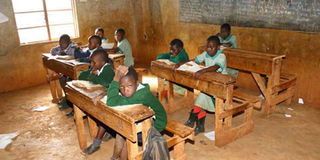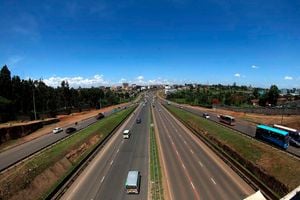Poor school enrolment blamed on low birth rate and migration

Class Four pupils of Ngooru Primary School in Tetu on November 16, 2015. PHOTO | JOSEPH KANYI | NATION MEDIA GROUP
What you need to know:
- According to the Basic Education Statistical Booklet, the national pupil to teacher ratio per class in 2014 stood at 42:1, which is within the international standard of 40:1.
- Statistics from the Kenya Demographic and Health Survey show that 67 per cent of married women in Nyeri are using modern contraceptives.
- Most families in Nyeri are now having fewer children than before.
Kihingo Primary School has only 70 pupils from Standard One to Eight, with each class having an average of nine learners.
The situation enables teachers to have one-on-one interaction with pupils.
The school is not unique. Primary schools in Nyeri County have recorded a decline in the number of pupils over the last five years.
Five schools in Tetu North, for instance, have an enrolment of less than 150 pupils.
The national average is three times this figure.
BASIC EDUCATION STATISTICAL BOOKLET
According to the Basic Education Statistical Booklet, the national pupil to teacher ratio per class in 2014 stood at 42:1, which is within the international standard of 40:1.
This means, on average, a primary school class has 42 pupils.
The figure drops to 35 if the teachers employed by school boards are taken into consideration. In some schools in Nyeri, the ratio is one teacher to 10 pupils.
What is the cause of the decline in enrolment?
DECREASING POPULATION
According to experts, migration, use of birth control and an increase in the number of schools are to blame for the decreasing population of pupils.
Kihingo Primary School Head Teacher Henry Mugweru Muthui blamed the trend on migration.
He said when squatters who had encroached on the Aberdare Forest at Gakanga were evicted, they moved to urban centres.
“The harsh terrain due to the school’s proximity to the Aberdare Range is also partly to blame for the trend.
I joined the school in 2011, and the population has never gone beyond 80,” said Mr Muthui.
Ngooru Primary School Head Teacher Sammy Gikonyo believes family planning is the main cause of the trend.
“Parents’ rate of giving birth is relatively low. Currently, we are enrolling 12 to 15 nursery schoolchildren per year. With the current trend, I fear I will one day enrol only five pupils,” said Mr Gikonyo.
Mr Gikonyo, however, dismissed claims that the rural-urban migration is the main cause of the low enrolment.
“I was posted here four years ago, and the population has been between 60 and 80. However, in the last two years, we experienced a slight improvement, with 100 pupils,” said Mr Gikonyo.
Kihingo and Ngooru primary schools are the worst hit, each having 70 and 91 pupils respectively.
Enrolment at Karunaini Primary School is also low.
The number of pupils has never exceeded 120 at any one time.
Njoguinu, Kahigiini and Kiamutiga are among other schools facing the challenge.
In the last census, the population of Nyeri stood at about 700,000, with the annual expenditure of every resident being on the rise in Kieni, Nyeri Town and Kieni constituencies.
MODERN CONTRACEPTIVES
Statistics from the Kenya Demographic and Health Survey show that 67 per cent of married women in Nyeri are using modern contraceptives.
However, Mr John Kiama, a resident of Tetu North, gave a different explanation.
He told the Nation that most parents were into agribusiness and earning enough to send their children to better schools.
According to him, this explains why there has been an exodus of pupils from public schools in the area to private educational institutions.
“We are spoilt for choice regarding good schools in this region.
They are not expensive either.
Our tea, coffee and dairy farming proceeds enable us to cater for our children’s fees.
It is important to also note that most families are having fewer children than before.
MIGRATION
Once our sons and daughters are educated, they move to urban areas with their children.
This results in a reduction in the population of this area,” said Mr Kiama.
An administrator at the county’s regional population coordination office said the migration might have been caused by several factors, including poor location of schools and failure by Constituency Development Fund officials from consulting with the Education ministry before constructing educational institutions.
“If a school is built in a village with a low population, it follows that the pupils’ numbers will be equally small.
We are also aware that some politicians are constructing schools before receiving approval from the Education ministry on the suitability of their chosen site,” said the administrator.
Mr Gikonyo dismissed claims that poor performance is a possible cause of the low population.
He said when he joined Ngooru Primary School, the performance was poor, but even when it improved, the population is yet to hit 100.





